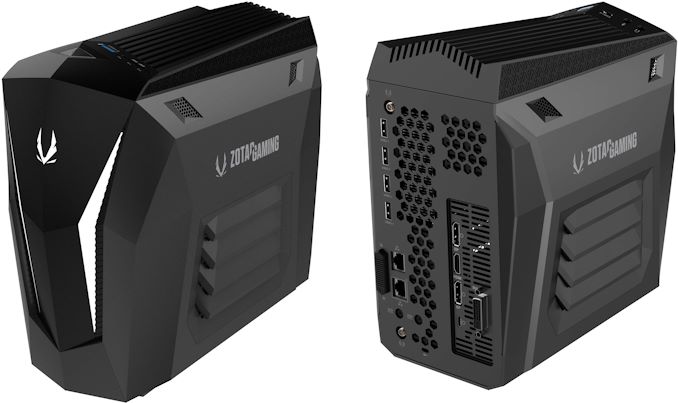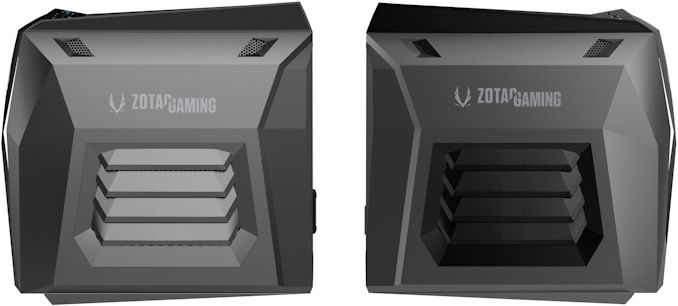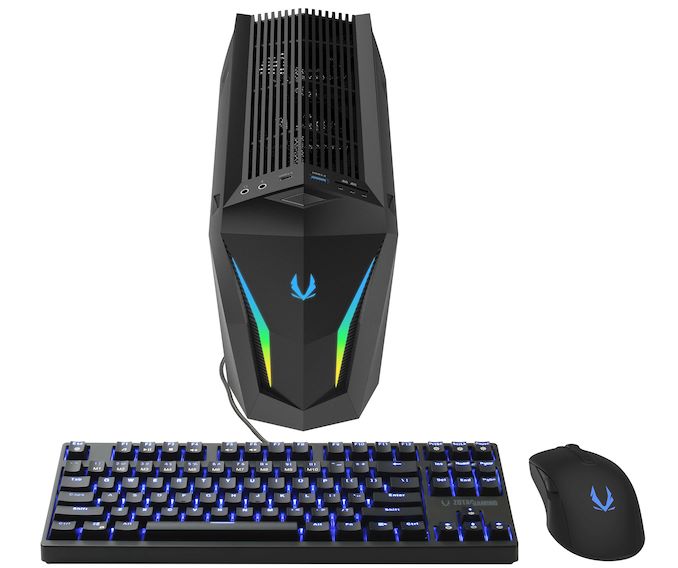ZOTAC Mek Mini: A Small High Performance Gaming PC
by Anton Shilov on March 22, 2019 1:00 PM EST- Posted in
- Desktop
- Intel
- ZOTAC
- NVIDIA
- Coffee Lake
- MEK
- MEK Mini
- Turing
- GeForce RTX

ZOTAC this week launched its small form-factor (SFF) Mek Mini desktop computer, aimed at gaming in a small volume. The system will be initially available in only one configuration but is designed to deliver good performance for gamers who prefer compact PCs.
Known primarily for its graphics cards, SFF machines, and small form-factor desktop barebones, ZOTAC has been trying to enter the market of retail gaming desktops for several years now. Back in 2017, the company introduced its ‘one-size-fits-all’ Mek1 gaming desktop that combined upgradeability with relatively compact dimensions. The initiative was considered a success, which is why the company rolled-out two gaming PCs in 2018: the Mek Ultra based on Intel’s HEDT platform, and the Mek Mini powered by Intel’s mainstream gaming platform. The former was released back in October, whereas the launch of the latter was delayed for some reason. This week, the company unveiled the final specifications of its Mek Mini that will go on sale in the near future.
Measuring 260.8×136×258.8 mm, the ZOTAC Mek Mini is based on six-core Intel’s Core i7-8700 processor accompanied by NVIDIA’s GeForce RTX 2070 graphics card with 8 GB of GDDR5. The system is equipped with 16 GB of DDR4 memory, a 240 GB PCIe/NVMe M.2 SSD, as well as a 2 TB 2.5-inch hard drive. The PC is powered by two 230 W external power bricks.
On the connectivity side of things, the Mek Mini has Rivet Networks’ Killer Wireless-AC 1550 802.11ac Wi-Fi + Bluetooth 5.0 controller, two GbE ports (one controlled by the Killer E2500 chip), five USB 3.0 Type-A ports, one USB 3.0 Type-C connectors (one on the GPU), an SD card reader, and 3.5-mm audio jacks. Meanwhile, the ZOTAC Gaming GeForce RTX 2070 has five display outputs (two DisplayPort 1.4, DVI-D, HDMI, USB-C) that can drive up to four monitors simultaneously.
Being aimed at gamers, ZOTAC’s Mek Mini has a very sophisticated cooling system to ensure longevity of components, consistent performance under high loads, and quiet operation. It also has addressable Spectra RGB lighting, supporting 13 pre-set lighting modes.
| ZOTAC Mek Mini | |||
| GM2070C700B GM2070C701B |
|||
| CPU | Intel Core i7-8700 6C/12T 3.2 GHz/4.6 GHz 12 MB LLC 65 W |
||
| PCH | Intel | ||
| Graphics | NVIDIA GeForce RTX 2070 2304 shader cores 36 ray tracing cores 288 tensor cores 144 texture units 64 ROPs 256-bit memory interface 8 GB of GDDR6 |
||
| Memory | 16 GB of DDR4 | ||
| Storage | 240 GB PCIe 3.0 x4 SSD 2 TB 2.5" SATA HDD |
||
| Wi-Fi | Killer Wireless-AC 1550 802.11ac Wi-Fi + Bluetooth 5.0 controller | ||
| Ethernet | Two Gigabit Ethernet with RJ45 connectors (one controlled by the Killer E2500) |
||
| Display Outputs | 1 × DVI-D DL 2 × DisplayPort 1.4 1 × HDMI 2.0 1 × USB-C |
||
| Audio | 3.5-mm audio connectors for speakers and microphone | ||
| USB | 1 × USB 3.0 Type-A (Front) 1 × USB 3.0 Type-C (Front) 4 × USB 3.0 Type-A (Back) |
||
| Other I/O | - | ||
| RGB Lighting | ZOTAC Spectra | ||
| Dimensions | Height | 205 mm | 8.07" | |
| Depth | 440 mm | 17.32" | ||
| Width | 327 mm | 12.87" | ||
| PSU | 2 × 230 W external power bricks | ||
| OS | Windows 10 Home 64-bit | ||
ZOTAC will offer two versions of the Mek Mini desktops. In some regions, the GM2070C700B machines will be shipped with a LED-lit mechanical gaming keyboard and an optical gaming mouse. In other regions the GM2070C701B system will ship without any controllers. In the US the system without the input devices and will cost $1599.99.
Related Reading:
- Zotac's Mek Mini: An Impressive Gaming Mini-PC
- ZOTAC Publishes Specifications of Mek Mini, Mek Ultra PCs
- ZOTAC Expands Mek Lineup with Mek Mini and Mek Ultra
- ZOTAC Preps SFF Workstation with NVIDIA’s Quadro, Intel’s 10 GbE NICs
Source: ZOTAC



















16 Comments
View All Comments
PeachNCream - Friday, March 22, 2019 - link
I think that it needs a few more configuration options so there is broader appeal. At the very least, there should be other network adapter options so buyers can select Intel or Realtek which would certainly help improve its on paper specs and appeal to the gaming crowd. Other GPUs would be nice too like the recently released 1660 variants. The front LEDs look basically non-functional, failing to indicate anything about system status or activity beyond "it's turned on" so dropping them in favor of a couple of small LEDs, one indicating power/standby and another blinking for disk activity, would be a cost savings and visual improvement. Lastly, dual external power supplies make the computer seem like a haphazardly designed system as they're inelegant to say the least. I'd also suggest changing the name as "Mek" strikes me as rather childish. Granted its only a product branding thing, but it is off-putting.Fix those things and I think Zotac will have a really good system. As-is, the core concept is solid, but the execution just comes off as chintzy, especially with the network adapter choice. I am amazed that OEMs are still trying to use Killer adapters in 2019.
bgrim - Friday, March 22, 2019 - link
Hi PeachNCream, I work with Rivet Networks - the folks that make Killer Networking products and we work extremely hard to put out high-performance networking products that prioritize gaming traffic and offer a lot of other cool features too. One of the cool things about this Zotac system is that since it has both Killer Ethernet and Wi-Fi, our DoubleShot Pro technology lets you not only use Ethernet and Wi-Fi at the same time - but also lets you decide what network traffic goes over each connection. Anyways, pretty cool stuff. Hope you give it a fair chance. Happy to answer other questions but my responses might be delayed until next week.PeachNCream - Friday, March 22, 2019 - link
Okay, I'll bite. How exactly do you set priorities on traffic after said packets leave the local system and hit my home router and beyond into the great, uncaring world of TELCO lines? The bottom line with software based packet prioritization is that there is nothing that software can do once it hits the wire/air or inbound packets arrive at the computer's adapter. Given hundreds or thousands of miles of fiber and copper plus many hops traffic traverses over equipment that doesn't care at all about priority no matter what the workstation says, I can't see how the first couple inches internal to my own system's buses will make a difference. When my kids are pummeling my link with Youtube and Netflix from other devices on my network to make my rural, you-can-have-10mbit-Century-Link-DSL-or-56k-dial-up-pal connection beg for a break, it doesn't matter what my PC does with packets leaving its own NIC. They get to wait in line. So where's the value-add at in running additional software on my machine and burning CPU cycles to manage what order packets leave while introducing additional complexity on top of an already flaky enough Windows network stack? (Or Linux, do you support Linux yet?)I give it to you that the switch to Intel hardware behind the sticker was a good move and I absolutely will nod that it's a poke in the right direction, but there are too many factors outside my computer's control in the wider world for the selling point of dumping game traffic out of my NIC first - something I can already control by closing other applications before firing up a game that needs network access - makes any measurable difference in sensitive benchmarks much less to my millisecond-precision-lacking gray matter when I'm at my keyboard.
ST33LDI9ITAL - Saturday, March 23, 2019 - link
Your marketing hype bs won’t work here. The people here are not your casual gaming crowd. And tbh, that isn’t “cool” at all... the absolute last thing I would want while plugged in is any traffic going over WiFi. The reality is many people got burned by your earlier overpriced products, and it left a sour taste and poor look towards you. Killer products are notorious for being overhyped, overpriced, and plagued with problems. A good router and modem with the right networking tweaks matters much more than the nic. Intel have a proven track record of working well and reliably, Hell even Realtek is more than capable nowadays.PeachNCream - Sunday, March 24, 2019 - link
I also fail to see any reasonable usage scenarios where I'd want to perform link aggregation (DoubleShot's industry standard terminology) between wireless and wired adapters. In gaming usage scenarios that rely on a WAN connection, it will make no positive difference with respect to network-induced latency given where traffic is flowing and, I'd contend, may introduce problems that would never crop up if a person was using a single adapter (wired or wireless as needed given the physical constraints of the environment).As someone who was a network engineer (now cybersecurity), I'm appalled at how Rivet presents its products. The marketing materials and methods have a predatory, used car salesman taste to say the least which is a twofold problem, I think. Firstly, as you've said, Killer NICs have had a long history of being outstandingly awful products in the past. Even if that isn't the case today and driver quality or the software networking package have improved significantly, that reputation will continue to haunt the company for as long as people that feel cheated are around. Secondly, present day features and sales tactics, including the damage control from its employees like the post above, assume a low level of buyer sophistication. Even Ian has once said in comments in defense of Rivet Networks that readers here will not understand the technology while discussing the lack of benchmarks or technical information published despite the positive coverage a lot of us objected to over the years. That marketing method is primitive to say the least, makes it appear that customers are looked down upon by the company, and implies Rivet Networks exists solely to generate profits off the foolish. That's an ugly cornerstone to say the least. Even if generation of profits as a reason to exist is true and we all know it, maintaining the illusion of mutual respect between customers and companies is vital over the long run so that intermediate hardware integrator businesses like Zotac don't lose sales in a misguided attempt to mark off the "premium gamer networking" checkbox when their designers are coming up with specifications for the next great RGB-cancer-l33t-fragz PC.
bgrim - If you're still here and reading, what I'm trying to explain is that Killer NICs were borderline at best and an atrocity at worst and your current approach to marketing needs a lot of work starting with convincing hardware review sites like Anandtech to post meaningful benchmarks representative of realistic usage scenarios that back up the premium categorization Rivet Networks clearly wants Killer NICs to occupy otherwise OEMs that buy your company's hardware are going to find those models getting the cold shoulder which in turn will eventually keep you folks from paying your mortgages and car loans which is not a fun place be when you've got 2.1 children, spouse, and catdog to feed. As it stands right now, people like me look for the following brands of network adapters:
1. Un-Rebranded Intel
2. RealTek
3. Everyone Else Except Rivet Networks
After number 3. we stop looking and go find a different product that meets our criteria. I think it's long overdue that Rivet seeks out a different set of selling points. Current solutions don't fix actual problems and its far too easy for even someone with a modest understanding of networking to realize they aren't getting a benefit. My suggestion - drop the Killer branding altogether as its pretty much radioactive at this point while at the same time seeking out a way to add value in a more substantial, measurable manner. I'm not sure how leveraged the company is at the moment and whether or not it can fund a transformation, but it seems like the best path forward at this point. It'll not only spare the company, but it'll do us a favor too since we won't have to be as cautious about what we're purchasing since we'll know the networking subsystem at least won't give us any "killer" surprises.
jordanclock - Monday, March 25, 2019 - link
You're right on all points. LAG is only useful when you need bandwidth and don't care about latency. I cannot think of a single scenario other than installs/updates where DoubleShot would help any game.wintermute000 - Monday, March 25, 2019 - link
So you make the networking equivalent to monster cables, except they also flake out all the time. Please just stop existing.PeachNCream - Sunday, March 31, 2019 - link
So much for coming around to respond. Then again, it's unlikely that there is a reasonable sounding way to circumvent the realities of networking.jtd871 - Friday, March 22, 2019 - link
For shame! 2 230W external bricks(!) seems like a wasted opportunity when good internal solutions, such as commercial fanless or "semi-passive" SFX units or even fully passive HDPlex brickless units are readily available in the 400W range. The overall ~29L volume should have been able to accommodate these with ease.Polpov - Saturday, March 23, 2019 - link
Real dimensions are 260.8mm x 136mm x 258.8mm (9.2L) according to ZOTAC official site. But your point is still valid, internal PSU at this size should be a non-issue, Dr Zaber Sentry 2.0 support SFX PSU at just 7L! Previous article about the Mek Mini mentionned a custom motherboard... double shame.